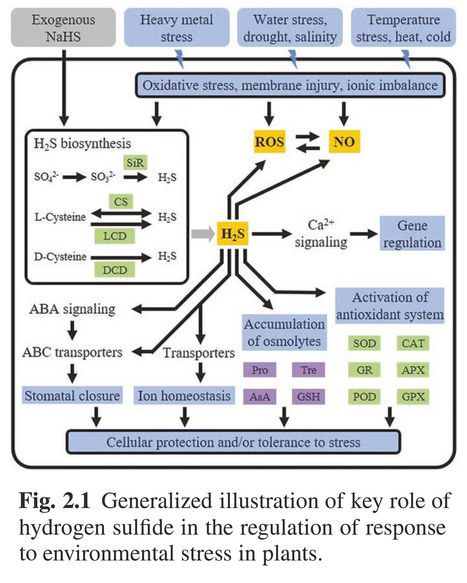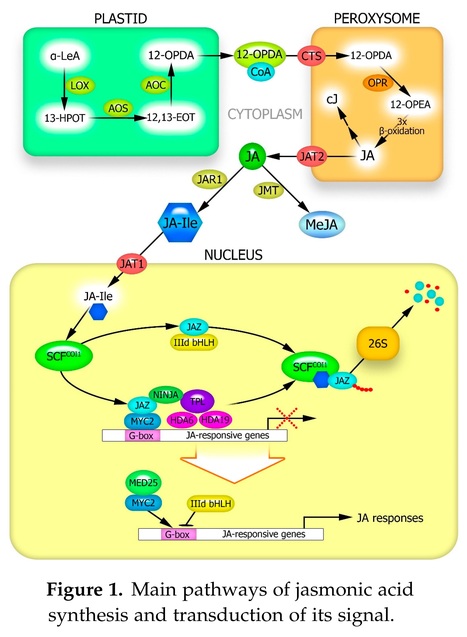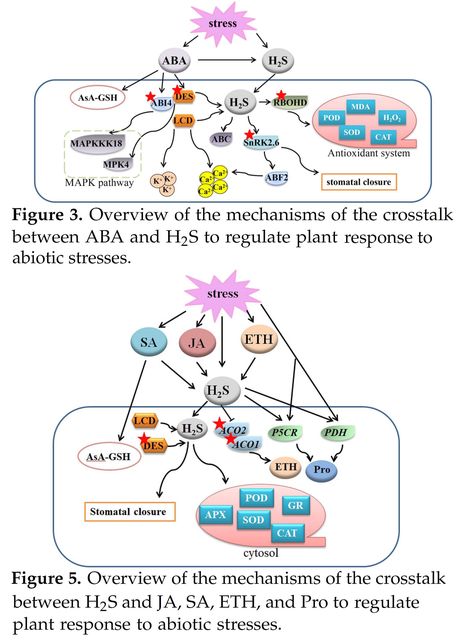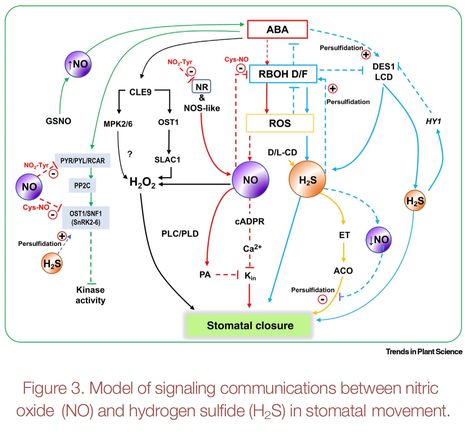 Your new post is loading...
 Your new post is loading...
Authors: Ruirui Yang, Hua Fang, Jing Li, Fujin Ye, Dengjing Huang, Xinfang Chen and Weibiao Liao.
Plant Stress (2024)
Highlights • Strigolactones participated in hydrogen sulfide-alleviated salt stress. • Hydrogen sulfide increased endogenous strigolactone content under salt stress. • Hydrogen sulfide enhanced strigolactone-related enzyme activity under salt stress. • Hydrogen sulfide increased strigolactone-related gene expression under salt stress. • Hydrogen sulfide alleviated salt stress by up-regulating SlD27 expression.
Abstract: "Strigolactones (SLs) and hydrogen sulfide (H2S) have both been shown to play important roles in plant growth, development, and environmental adaption. At present, there was no reported on the mechanism by which SLs might participate in H2S-induced salt tolerance. In this study, tomato (Solanum lycopersicum L. ‘Micro-Tom’) was used to investigate the role of SLs and H2S and their relationship under salt stress. Our results show that 25 µM H2S donor sodium hydrosulfide (NaHS) and 15 µM SLs synthetic analogue GR24 significantly promoted tomato seedling growth under salt stress. TIS108 (3 µM, a SLs synthesis inhibitor) and hypotaurine (HT, 300 µM, a H2S scavenger) inhibited the positive role of NaHS and GR24 under salt stress, respectively. Meanwhile, NaHS treatment significantly increased endogenous SL content, the activity of SL synthesis-related enzymes CCD7 and CCD8, and the expression of SL synthesis-related genes (SlD27, SlD14, SlMAX1, and SlMAX2) under salt stress. Further, after silencing a SL synthesis-related gene SlD27, the relieving role of NaHS in salt stress was basically eliminated. Silencing of SlD27 decreased endogenous SL content, while NaHS did not enhance the endogenous SL content in SlD27-silencing seedling. Therefore, H2S might enhance salt tolerance in tomato seedlings by up-regulating the expression of SL synthesis-related gene SlD27."
Authors: Verena Iven, Isabeau Vanbuel, Sophie Hendrix and Ann Cuypers.
Journal of Experimental Botany (2023)
Abstract: "Cadmium (Cd) uptake from polluted soils inhibits plant growth and disturbs physiological processes, at least partly due to disturbances in the cellular redox environment. Although the sulfur-containing antioxidant glutathione is important in maintaining redox homeostasis, its role as an antioxidant can be overruled by its involvement in Cd chelation as a phytochelatin precursor. Following Cd exposure, plants rapidly invest in phytochelatin production, thereby disturbing the redox environment by transiently depleting glutathione concentrations. Consequently, a network of signalling responses is initiated, in which the phytohormone ethylene is an important player involved in the recovery of glutathione levels. Furthermore, these responses are intricately connected to organellar stress signalling and autophagy, and contribute to cell fate determination. In general, this may pave the way for acclimation (e.g. restoration of glutathione levels and organellar homeostasis) and plant tolerance in the case of mild stress conditions. This review addresses connections between these players and discusses the possible involvement of the gasotransmitter hydrogen sulfide in plant acclimation to Cd exposure.
Authors: Soumya Mukherjee, Francisco J. Corpas.
Plant, Cell & Environment (2023)
Abstract: "Hydrogen peroxide (H2O2) is a reactive oxygen species (ROS) and a key modulator of the development and architecture of the root system under physiological and adverse environmental conditions. Nitric oxide (NO) and hydrogen sulfide (H2S) also exert myriad functions on plant development and signaling. Accumulating pieces of evidence show that depending upon the dose and mode of applications, NO and H2S can have synergistic or antagonistic actions in mediating H2O2 signaling during root development. Thus, H2O2-NO- H2S crosstalk might essentially impart tolerance to elude oxidative stress in roots. Growth and proliferation of root apex involve crucial orchestration of NO- and H2S-mediated ROS signaling which also comprise other components including mitogen-activated protein kinase, cyclins, cyclin-dependent kinases, respiratory burst oxidase homolog (RBOH), and Ca2+ flux. This assessment provides a comprehensive update on the cooperative roles of NO and H2S in modulating H2O2 homeostasis during root development, abiotic stress tolerance, and root-microbe interaction. Furthermore, it also analyses the scopes of some fascinating future investigations associated with strigolactone and karrikins concerning H2O2-NO-H2S crosstalk in plant roots."
Authors: Danmei Liu, Ting Guo, Jianing Li, Yuan Hao, Dan Zhao, Longdan Wang, Zhiqiang Liu, Liping Zhang, Zhuping Jin and Yanxi Pei.
Plant Science (2022)
Highlights: • Hydrogen sulfide (H2S) inhibited the initiation of the tomato pedicel abscission process. • H2S reconstructed a basipetal auxin gradient along the treated tomato pedicel. • H2S played an important role in the transcription level. • The ligand-receptor and the ROX systems are potential regulatory nodes downstream auxin in tomato pedicel abscission.
Abstract: "Abscission is an important developmental process and an essential agricultural trait. Auxin and ethylene are two phytohormones with important roles in the complex, but still elusive signaling network of abscission. Here, we found that hydrogen sulfide (H2S), a newly identified gasotransmitter, inhibits the initiation of tomato pedicel abscission. The underlying mechanism was explored through transcriptome profile analysis in various pedicel tissues with or without H2S treatment in the early abscission stage. The data suggested that H2S strongly influences the global transcription of pedicel tissues, exerts differential expression regulation along the pedicel, and markedly influences both the auxin and ethylene signaling pathways. Computational analysis revealed that H2S reconstructs a basipetal auxin gradient along the pedicel at 4 h after treatment; this finding was further substantiated by the GUS-staining results of DR5::GUS pedicels. The inhibitory effect of H2S to the ethylene signaling pathway might be an indirect action. Moreover, the subtilisin-like proteinase family members involved in the release of peptide signal molecules are critical components of the abscission signaling network downstream of auxin and ethylene."
Authors: Sheng Zheng, Min Su, Lu Wang, Tengguo Zhang, Juan Wang, Huichun Xie, Xuexia Wu, Syed Inzimam Ul Haq and Quan-Sheng Qiu.
Journal of Plant Physiology (2021)
Abstract: "Cold stress is one of the harsh environmental stresses that adversely affect plant growth and crop yields in the Qinghai-Tibet Plateau. However, plants have evolved mechanisms to overcome the impact of cold stress. Progress has been made in understanding how plants perceive and transduce low-temperature signals to tolerate cold stress. Small signaling molecules are crucial for cellular signal transduction by initiating the downstream signaling cascade that helps plants to respond to cold stress. These small signaling molecules include calcium, reactive oxygen species, nitric oxide, hydrogen sulfide, cyclic guanosine monophosphate, phosphatidic acid, and sphingolipids. The small signaling molecules are involved in many aspects of cellular and physiological functions, such as inducing gene expression and activating hormone signaling, resulting in upregulation of the antioxidant enzyme activities, protestantesimo accumulation, malondialdehyde reduction, and photosynthesis improvement. We summarize our current understanding of the roles of the small signaling molecules in cold stress in plants, and highlight their crosstalk in cold signaling transduction. These discoveries help us understand how the plateau plants adapt to the severe alpine environment as well as to develop new crops tolerating cold stress in the Qinghai-Tibet Plateau.
Authors: Mehmet Tufan Oz and Fusun Eyidogan.
In book: Hydrogen Sulfide and Plant Acclimation to Abiotic Stresses (2021)
Abstract: "Hydrogen sulfide (H2S), a phytotoxic gas, is considered a signaling molecule at low concentrations with multiple physiological functions in plants during growth, development, germination, and response mechanisms to abiotic stress. Several reports have indicated that H2S is released in plant cells as a crucial signal for the survival under different abiotic stress conditions. H2S provides systemic resistance to different abiotic stress conditions mainly by reestablishing redox homeostasis, enhancing osmolyte accumulation, maintaining ion balance, and regulating gene expression. It also improves the plant tolerance to abiotic stress with its capacity to react with thiol groups. Like other gaseous signal molecules, H2S is integrated in complex signaling networks with various second messengers such as calcium, hydrogen peroxide (H2O2), nitric oxide (NO), and abscisic acid (ABA). The objective of this review is to summarize the potential physiological functions of H2S under various abiotic stresses."
Authors: Angeles Aroca, Jing Zhang, Yanjie Xie, Luis C. Romero and Cecilia Gotor.
Journal of Experimental Botany (2021
Abstract: "Hydrogen sulfide (H2S) is a signaling molecule that regulates critical processes and allows plants to adapt to adverse conditions. The molecular mechanism underlying the H2S action relies on its chemical reactivity, and the mainly characterized is the persulfidation, which involves the modification of protein thiol groups, resulting in the formation of persulfide groups. This modification derives a change of protein function, altering catalytic activity or intracellular location and inducing important physiological effects. H2S cannot react directly with thiols but instead can react with oxidized cysteine residues; therefore, H2O2 signaling through sulfenylation is required for persulfidation. A comparative study performed in this review reveals 82% of identity between the sulfenylome and persulfidome. With regard to abscisic acid (ABA) signaling, widespread evidence shows an interconnection between H2S and ABA in the plant response to environmental stress. Proteomic analyses have revealed persulfidation of several proteins involved in the ABA signaling network and have shown that persulfidation is triggered in response to ABA. In guard cells, a complex interaction of H2S and ABA signaling has also been described, and the persulfidation of specific signaling components seems to be the underlying mechanism."
Authors: Mingjian Zhou, Jing Zhang, Jie Shen, Heng Zhou, Didi Zhao, Cecilia Gotor, Luis C. Romero, Ling Fu, Zongmin Li, Jing Yang, Wenbiao Shen, Xingxing Yuan and Yanjie Xie.
Molecular Plants (2021)
Abstract: "Hydrogen sulfide (H2S) is a signaling molecule that regulates plant hormone and stress responses. The phytohormone abscisic acid (ABA) plays an important role in plant adaptation to unfavorable environmental conditions and induces the persulfidation of L-CYSTEINE DESULFHYDRASE1 (DES1) and the production of H2S in guard cells. However, it remains largely unclear how H2S and protein persulfidation participate in the relay of ABA signals. In this study, we discovered that ABSCISIC ACID INSENSITIVE 4 (ABI4) acts downstream of DES1 in the control of ABA responses in Arabidopsis. ABI4 undergoes persulfidation at Cys250 that is triggered in a time-dependent manner by ABA, and loss of DES1 function impairs this process. Cys250 and its persulfidation are essential for ABI4 function in the regulation of plant responses to ABA and the H2S donor NaHS during germination, seedling establishment, and stomatal closure, which are abolished in the ABI4Cys250Ala mutated variant. Introduction of the ABI4Cys250Ala variant into the abi4 des1 mutant did not rescue its hyposensitivity to ABA. Cys250 is critical for the binding of ABI4 to its cognate motif in the promoter of Mitogen-Activated Protein Kinase Kinase Kinase 18 (MAPKKK18), which propagates the MAPK signaling cascade induced by ABA. Furthermore, the DES1-mediated persulfidation of ABI4 enhances the transactivation activity of ABI4 toward MAPKKK18, and ABI4 can bind the DES1 promoter, forming a regulatory loop. Taken together, these findings advance our understanding of a post-translational regulatory mechanism and suggest that ABI4 functions as an integrator of ABA and MAPK signals through a process in which DES1-produced H2S persulfidates ABI4 at Cys250."
|
Authors: Yuriy E. Kolupaev, Tetiana O. Yastreb and Alexander P. Dmitriev.
Plants (2023)
Abstract: "Plant cells respond to stress by activating signaling and regulatory networks that include plant hormones and numerous mediators of non-hormonal nature. These include the universal intracellular messenger calcium, reactive oxygen species (ROS), gasotransmitters, small gaseous molecules synthesized by living organisms, and signal functions such as nitrogen monoxide (NO), hydrogen sulfide (H2S), carbon monoxide (CO), and others. This review focuses on the role of functional linkages of jasmonic acid and jasmonate signaling components with gasotransmitters and other signaling mediators, as well as some stress metabolites, in the regulation of plant adaptive responses to abiotic stressors. Data on the involvement of NO, H2S, and CO in the regulation of jasmonic acid formation in plant cells and its signal transduction were analyzed. The possible involvement of the protein components of jasmonate signaling in stress-protective gasotransmitter effects is discussed. Emphasis is placed on the significance of the functional interaction between jasmonic acid and signaling mediators in the regulation of the antioxidant system, stomatal apparatus, and other processes important for plant adaptation to abiotic stresses."
Authors: Zhi-Xin Xiang, Wen Li, Ying-Tang Lu and Ting-Ting Yuan.
The Plant Journal (2023)
Abstract: "Hydrogen sulfide (H2S) promotes plant tolerance against various environmental cues, and D-cysteine desulfhydrase (DCD) is an enzymatic source of H2S to enhance abiotic stress resistance. However, the role of DCD-mediated H2S production in root growth under abiotic stress remains to be further elucidated. Here, we reported that DCD-mediated H2S production alleviates osmotic stress-mediated root growth inhibition via promoting auxin homeostasis. Osmotic stress up-regulated DCD gene transcript and DCD protein levels, thus H2S production in roots. When subjected to osmotic stress, a dcd mutant showed more severe root growth inhibition, whereas the transgenic lines DCDox overexpressing DCD exhibited less sensitivity to osmotic stress in terms of longer root compared with the wild type. Moreover, osmotic stress inhibited root growth through repressing auxin signaling, but H2S treatment significantly alleviated osmotic stress-mediated inhibition of auxin. Under osmotic stress, auxin accumulation was increased in DCDox but decreased in dcd mutant. H2S promoted auxin biosynthesis genes expressions and auxin efflux carrier PIN-FORMED 1 (PIN1) protein level under osmotic stress. Together, our results revealed that mannitol-induced DCD and H2S in roots promote auxin homeostasis, contributing to alleviating the inhibition of root growth under osmotic stress."
Authors: Angeles Aroca and Cecilia Gotor.
FEBS Letters (2022)
Abstract: "Hydrogen sulfide is a signaling molecule with a well-established impact on both plant and animal physiology. Intense investigation into the regulation of autophagy by sulfide in Arabidopsis thaliana has revealed that the post-translational modification of persulfidation/S-sulfhydration plays a key role. In this review focused on plants, we discuss the nature of the sulfide molecule involved in the regulation of autophagy, the final outcome of this modification, and the persulfidated autophagy proteins identified so far. A detailed outline of the actual knowledge of the regulation mechanism of the autophagy-related proteins ATG4a and ATG18a from Arabidopsis by sulfide is also included. This information will be instrumental for furthering research on the regulation of autophagy by sulfide."
Authors: Chunlei Wang, Yuzheng Deng, Zesheng Liu and Weibiao Liao.
International Journal of Molecular Sciences (2021)
Abstract: "Hydrogen sulfide (H2S) has recently been considered as a crucial gaseous transmitter occupying extensive roles in physiological and biochemical processes throughout the life of plant species. Furthermore, plenty of achievements have been announced regarding H2S working in combination with other signal molecules to mitigate environmental damage, such as nitric oxide (NO), abscisic acid (ABA), calcium ion (Ca2+), hydrogen peroxide (H2O2), salicylic acid (SA), ethylene (ETH), jasmonic acid (JA), proline (Pro), and melatonin (MT). This review summarizes the current knowledge within the mechanism of H2S and the above signal compounds in response to abiotic stresses in plants, including maintaining cellular redox homeostasis, exchanging metal ion transport, regulating stomatal aperture, and altering gene expression and enzyme activities. The potential relationship between H2S and other signal transmitters is also proposed and discussed."
Authors: Francisco J. Corpas, Salvador González-Gordo and José M. Palma.
In book: Hydrogen Sulfide and Plant Acclimation to Abiotic Stresses (2021)
Abstract: "Fruit ripening is a complex physiological process involving many external modifications affecting shape, color, flavor, and metabolite composition, among others, which are consequence of deeper changes at biochemical, molecular, and cellular level. Hydrogen sulfide (H2S) is a gasotransmitter molecule that is endogenously produced in plant cells by enzymatic processes during sulfur metabolism. At present, H2S is recognized as a new signaling molecule because it has the capacity to affect protein function through a posttranslational modification (PTM) designated persulfidation. The present chapter has the goal to provide an updated comprehensive overview of the H2S metabolism and its implication in the ripening of climacteric and non-climacteric fruits. Moreover, the beneficial effects exerted by the exogenous application of H2S during the ripening period and postharvest storage are also overviewed.
Authors: Vipul Mishra, Pooja Singh, Durgesh Kumar Tripathi, Francisco J. Corpas and Vijay Pratap Singh.
Trends in Plant Science (2021)
Highlights: NO and H2S have signaling properties through protein post-translational modifications (PTMs) and by their crosstalk with other cellular compounds, including phytohormones, hydrogen peroxide, or calcium, among others. NO and H2S regulate protein function mainly by cysteine thiol-based redox switches (S-nitrosation and persulfidation, respectively) that compete with each other and with other PTMs (S-glutathionylation, S-cyanylation, S-acylation, and S-sulfenylation). The prevalence of one will depend on the subcellular and cellular redox context, which in turn will depend on the physiological or stress situation in which it occurs. NO and H2S can function in a coordinated way in certain signaling cascades, although there are processes in which they do so independently.
Abstract: "Nitric oxide (NO) and hydrogen sulfide (H2S) are gasotransmitters, which are involved in almost all plant physiological and stress-related processes. With its antioxidant regulatory properties, NO on its own ameliorates plant stress, while H2S, a foul-smelling gas, has differential effects. Recent studies have shown that these signaling molecules are involved in intertwined pathway networks. This is due to the contrasting effects of NO and H2S depending on cell type, subcellular compartment, and redox status, as well as the flux and dosage of NO and H2S in different plant species and cellular contexts. Here, we provide a comprehensive review of the complex networks of these molecules, with particular emphasis on root development, stomatal movement, and plant cell death."
Authors: Anna Siodmak and Heribert Hirt.
Molecular Plant (2021)
Abstract: "Hydrogen sulfide (H2S) is an important signaling molecule in plants. It is a small gasotransmitter with high permeativity through lipid membranes. H2S can convert the mercapto groups (Cys–SH) of the amino acid cysteine into hydropersulfide groups (–Cys–SSH). This process is called persulfidation. Post-translational modifications such as persulfidation can play an important role in protein functionality, altering protein conformation and/or activity. In plants, H2S can be generated within guard cells by CYSTEINE-DESULFHYDRASES, such as DES1, by degradation of cysteines into H2S, ammonia, and pyruvate (Zhang et al., 2020). H2S was reported to take part in physiological processes, such as stress response, and in the regulation of the functions of phytohormones such as salicylic acid and abscisic acid (ABA) (Pandey and Gautam, 2020). Although the mechanism of how H2S affects ABA signaling pathways is not well understood, two recent studies by Chen et al. (2020) and Zhou et al. (2021) shed light on this topic, reporting how H2S-induced persulfidation regulates the stomatal ABA signaling pathway."
Authors: Mingjian Zhou, Heng Zhou, Jie Shen, Zhirong Zhang, Cecilia Gotor, Luis C. Romero, Xingxing Yuan and Yanjie Xie.
Plant Growth Regulation (2021)
Abstract: "The healthy growth of plants is inseparable from the joint action of many metabolic regulators, particularly the signaling molecules. Hydrogen sulfide (H2S), which was considered toxic previously, has now been regarded as a burgeoning endogenous gaseous transmitter. H2S is involved in the whole life cycle of plants orderly, regulating essential plant processes such as seed germination, root growth, flowering, anti-aging of post-ripening by affecting corresponding gene expression and subsequent enzyme activities, as well as crosstalk with plant hormones and other signaling molecules. The research on H2S physiology entering an exponential exploration era, with significant progress has been made on many fronts of H2S function. However, the research on its molecular mechanism is still fragmented. In this review, we collect recent up-dates from physiological function to molecular biological mechanism of biological processes for H2S participating throughout plants’ life cycle, and present a brief outlook for future research."
|




 Your new post is loading...
Your new post is loading...





















